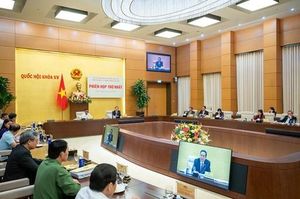Hanoi is poised to undergo a significant administrative overhaul that will abolish district-level government units and reduce the number of commune-level units by roughly 50% by July 1, 2025. This decision comes in response to the central government's directive aimed at streamlining local governance in the capital.
As of now, Hanoi comprises 30 district-level administrative units, which include 12 districts, 17 rural districts, and one town. Following the reorganization set to take place at the end of 2024, the number of commune-level administrative units will drop from 526 to approximately 260, encompassing 160 wards, 345 communes, and 21 towns.
During a press conference on April 6, 2025, Deputy Minister of Home Affairs Nguyen Thi Ha addressed concerns regarding the practical implications of this restructuring for residents and businesses. She assured that the Ministry of Home Affairs is actively working on a project to be submitted to the Politburo and the Central Executive Committee that will outline the new governance model. This model will consist of just two levels: provincial and commune, effectively eliminating the district level.
"The local government at the commune level will be tasked with additional responsibilities previously held by the district level, thus gaining more authority and resources to meet the needs of the community," Nguyen Thi Ha stated. This transition aims to enhance the efficiency of local governance and ensure that administrative processes are simplified for citizens.
One of the pressing concerns surrounding this restructuring is the naming of the new administrative units. At a meeting on April 3, 2025, Mr. Tran Dinh Canh, Director of the Hanoi Department of Home Affairs, outlined the principles for naming the new communes and wards. He emphasized that the new names should be easily recognizable, concise, and scientifically sound. For instance, areas may be named using ordinal numbers, such as Thanh Xuan 1 and Thanh Xuan 2, or they may retain names from their previous district designations.
"We encourage the use of historically significant names that have been well-received by the local community," Canh added, highlighting that names from the historical inner city, such as Hoan Kiem, would be preserved in the new ward designations.
The Ministry of Home Affairs is also focused on ensuring that the transition is seamless for the existing workforce. As of December 31, 2024, there are over 212,600 commune-level civil servants, with 92.4% holding university degrees. The draft Law on Cadres and Civil Servants, currently under review, proposes to maintain the current staffing levels until a comprehensive review and restructuring is completed.
"The government is committed to preserving the current salary levels of civil servants during this transition to avoid disruption in services for the community," emphasized Nguyen Thi Ha. She noted that the new model would include public administrative centers at the commune level to facilitate smoother interactions between citizens and government.
Moreover, the draft law suggests that civil servants will undergo a unified civil service regime that applies from the central to the commune level, removing distinctions that previously existed between different tiers of government. This change aims to streamline operations and improve governance efficiency.
At the same time, the government is aware of the potential impact on local officials and employees. Policies are being developed to provide support for those affected by the restructuring, including options for early retirement or reassignment based on their qualifications and capabilities.
"We will ensure that there are no overlaps or gaps in responsibilities during this transition, allowing local governments to function effectively without hindering economic and social development," stated Minister and Chairman of the Government Office, Tran Van Son.
In light of these changes, there is a palpable sense of anticipation among residents and local leaders in Hanoi. Many are hopeful that the new governance model will lead to more responsive and effective local administration. However, questions remain about how well these changes will be implemented and whether the benefits will be felt by the community.
As Hanoi prepares for this significant transformation, the focus will undoubtedly be on maintaining continuity in services and ensuring that the voices of the citizens are heard throughout the process. The government’s commitment to transparency and community engagement will be crucial as the city embarks on this new chapter in its administrative history.








